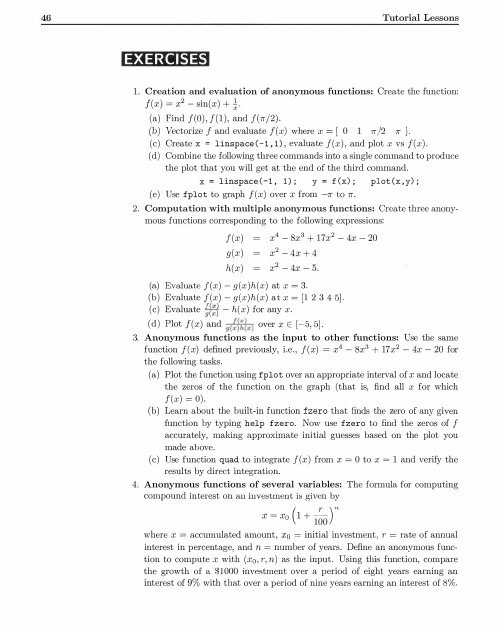Create successful ePaper yourself
Turn your PDF publications into a flip-book with our unique Google optimized e-Paper software.
46 Tutorial Lessons<br />
EXERCISES<br />
1. Creation and evaluation of anonymous functions: Create the function:<br />
f(x) = x 2 - sin(x) + -<br />
(a) Find f(O), f(1), and f(n/2).<br />
(b) Vectorize f and evaluate f ( x) where x = [ 0 1 n /2 1r J.<br />
(c) Create x = linspace (-1,1) , evaluate f(x), and plot x vs f(x) .<br />
(d) Combine the following three commands into a single command to produce<br />
the plot that you will get at the end of the third command.<br />
x = linspace(-1, 1) ; y = f(x) ; plot (x,y) ;<br />
(e) Use fplot to graph f(x) over x from -n to n.<br />
2. Computation with multiple anonymous functions: Create three anonymous<br />
functions corresponding to the following expressions:<br />
f(x)<br />
x 4 -8x3 +17x 2 -4x-20<br />
g ( x) x 2 - 4x + 4<br />
h(x)<br />
x 2 -4x-5.<br />
(a) Evaluate f(x) - g(x)h(x) at x = 3.<br />
(b) Evaluate j(x) - g(x)h(x) at x = [1 2 3 4 5] .<br />
(c) Evaluate :\ - h(x) for any x.<br />
(d) Plot f(x) and g(itx) over x E: [-5, 5].<br />
3. Anonymous functions as the input to other functions: Use the same<br />
function f ( x) defined previously, i.e., f ( x) = x 4 - 8x3 + 17 x 2 - 4x - 20 for<br />
the following tasks.<br />
(a) Plot the function using fplot over an appropriate interval of x and locate<br />
the zeros of the function on the graph (that is, find all x for which<br />
f(x) = 0).<br />
(b) Learn about the built-in function fzero that finds the zero of any given<br />
function <strong>by</strong> typing help fzero. Now use fzero to find the zeros of f<br />
accurately, making approximate initial guesses based on the plot you<br />
made above.<br />
(c) Use function quad to integrate f(x) from x = 0 to x = 1 and verify the<br />
results <strong>by</strong> direct integration.<br />
4. Anonymous functions of several variables: The formula for computing<br />
compound interest on an investment is given <strong>by</strong><br />
( r ) "<br />
X = Xo 1 + lOO<br />
where x = accumulated amount, x0 = initial investment, r = rate of annual<br />
interest in percentage, and n = number of years. Define an anonymous function<br />
to compute x with (x0, r, n) as the input. Using this function, compare<br />
the growth of a $1000 investment over a period of eight years earning an<br />
interest of 9% with that over a period of nine years earning an interest of 8%.



